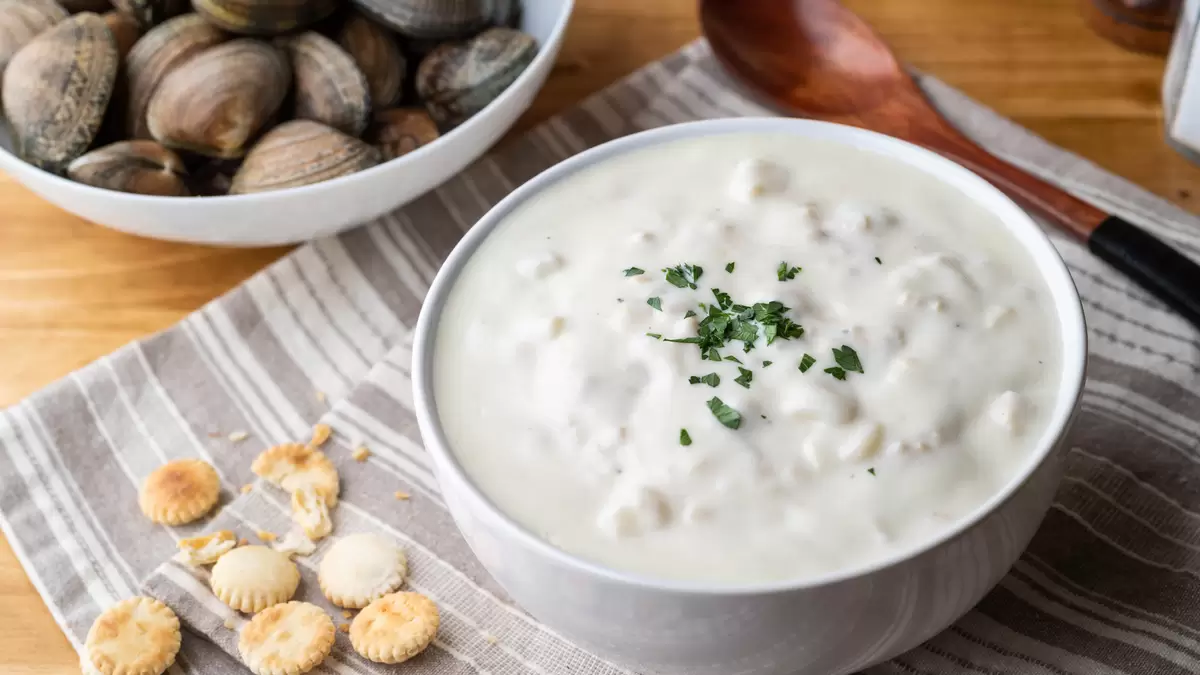Join Our Newsletter
Get our best recipes and health tips delivered right to your inbox!

Few soups are as comforting as a steaming bowl of clam chowder. Creamy, hearty, and filled with potatoes and clams, it’s a classic cold-weather favorite. But if you’ve ever wondered, “Is clam chowder healthy?”, the answer depends in part on which type of clam chowder you’re eating.
There are two main versions of this popular soup—New England clam chowder and Manhattan clam chowder. Both feature tender clams and savory vegetables, but the difference in their base—cream vs. tomato—has a big impact on nutrition.
Here’s how these two types of clam chowder compare and whether this soup can fit into a healthy eating plan, with tips to make healthier clam chowder from the dietitians at Health eCooks.
New England clam chowder is the version most people picture when they think of chowder. It’s thick and creamy, thanks to ingredients like milk, cream, and butter. While it’s undeniably comforting, the creamy base often contains a high amount of calories, fat, and sodium, making it challenging to answer “yes” to the question, “Is clam chowder good for you?”
Here’s are some typical nutrition stats for a one-cup serving of New England clam chowder:
The clams add protein and minerals like iron and vitamin B12, but the creamy base can overshadow those benefits. If you’re watching your weight, cholesterol, or blood pressure, New England clam chowder is best enjoyed as an occasional treat rather than a regular meal.
Of course, all New England clam chowder recipes are different, and there are healthier versions of this popular comfort food. Restaurant and canned versions of the soup are usually highest in fat, sodium, and calories, but you can make homemade clam chowder that’s healthier. Try this Healthy Clam Chowder, made with a lighter but still creamy base, as well as clams, vegetables, potatoes, and turkey bacon.
Manhattan clam chowder is a lighter version of this soup favorite, using a tomato-based broth with clams, potatoes, carrots, celery, and herbs. This makes it lower in fat and calories, as well as more nutrient-dense.
A one-cup serving of Manhattan clam chowder typically contains about:
Because there’s no cream, Manhattan chowder is a better option for weight loss and heart health. It’s still fairly high in sodium, however, especially if canned, but it provides plenty of flavor without the heaviness of its New England cousin.
If weight loss is your goal, Manhattan clam chowder is the better choice. With about half the calories and a fraction of the fat, it’s easier to fit into a low-calorie diet. New England clam chowder, while filling, can quickly add up in calories and fat, especially if you eat a large bowl with bread or crackers.
Clams themselves are good for your heart since they provide omega-3s, lean protein, and vitamin B12. The problem is the creamy base of New England chowder, which is usually high in saturated fat. Over time, too much saturated fat may raise LDL cholesterol and increase heart disease risk. Manhattan chowder, with its tomato base and lighter profile, is a more heart-friendly option.
No matter which version you prefer, you can make clam chowder a little healthier with these tips:
Still wondering if clam chowder is good for you? It turns out that the healthfulness of clam chowder depends on the type you eat, as well as whether it’s from a restaurant, a can, or your favorite recipe. New England clam chowder is creamy and satisfying but typically high in fat, calories, and sodium, making it more of an occasional indulgence. Manhattan clam chowder is lighter and packed with flavor, making it a better everyday choice, especially if you’re focused on weight loss or heart health. But no matter which type of clam chowder you prefer, you can enjoy clam chowder as part of a balanced diet with a few simple swaps and smart portion sizes.